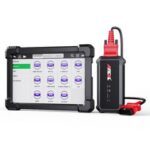Understanding Electric Car Obd2 systems is crucial for modern vehicle maintenance. While traditional cars rely on OBD2 for diagnostics, electric vehicles (EVs) present a slightly different landscape. This article explores how OBD2 interfaces with EVs, highlighting key differences and what you need to know.
Many electric vehicles, particularly those built on platforms shared with internal combustion engine (ICE) cars, utilize the conventional OBD2 standard. Vehicles like the Volkswagen e-Golf exemplify this, employing ISO 15765 protocol and an OBD2 connector. These EVs can still communicate brand-specific data, including electric powertrain diagnostics, through proprietary systems. Parameters unique to EVs, such as the state of charge (SoC), battery temperature, and the status of cooling or heating systems, are monitored by dedicated Electronic Control Units (ECUs).
However, the standardized OBD2 system, while present, has limitations in the EV context. Standard diagnostic code readers may display codes irrelevant to EVs, like the P01XX series related to fueling systems. The focus in EVs shifts to parameters not initially considered in standard OBD2 design, such as battery health and charging efficiency.
Tesla vehicles represent a unique approach. Known for their brand-specific solutions, some Tesla models, like the Model 3, use adapters to bridge to OBD2 connectors. This is noteworthy considering EU regulations like the EOBD standard, which is very similar to OBD2 and mandatory for passenger vehicles in the M1 category registered in Europe after specific dates (2001 for petrol, 2004 for diesel). While the applicability of EOBD to EVs during its initial legislation is debatable, the need for standardized diagnostics in EVs is becoming increasingly apparent.
Furthermore, EVs communicate vital parameters with charging stations for safe and efficient charging. The Open Charge Alliance provides valuable insights into these communication protocols. For deeper information, resources are available at Open Charge Alliance.
In conclusion, electric car OBD2 compatibility is evolving. While many EVs incorporate OBD2 for basic diagnostics, the system’s capabilities are stretched by the unique demands of electric powertrains. Understanding these nuances is essential for effective EV maintenance and diagnostics.
